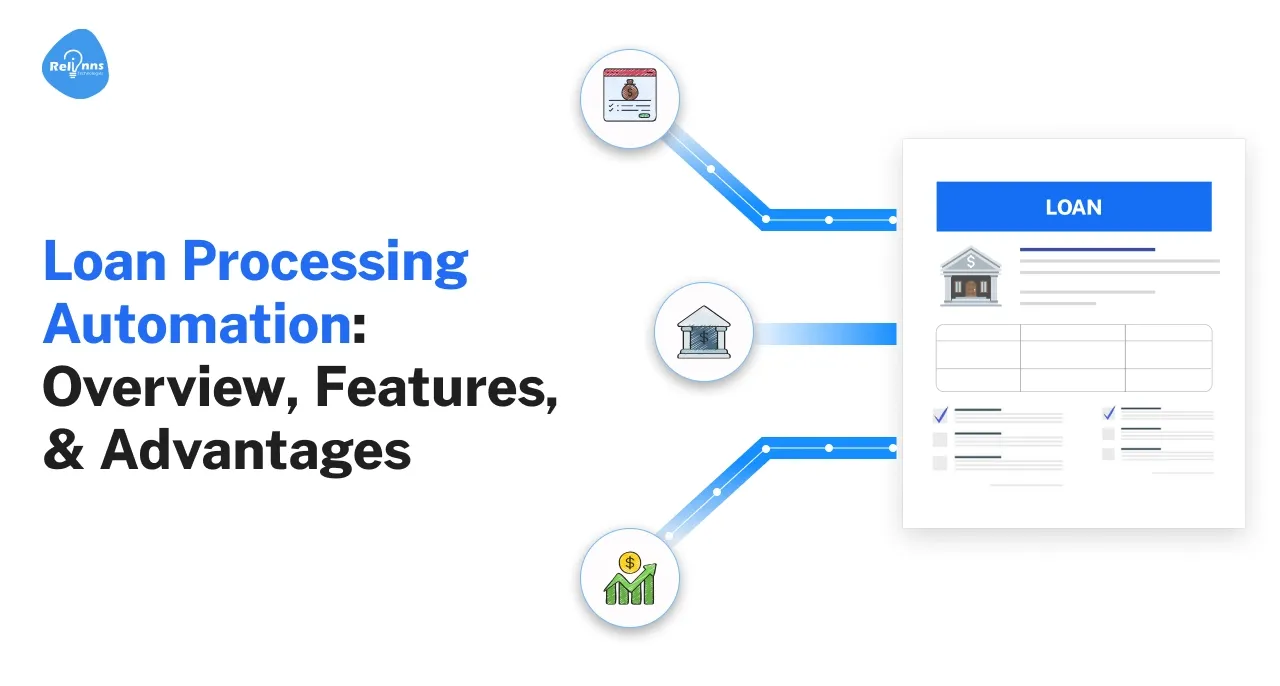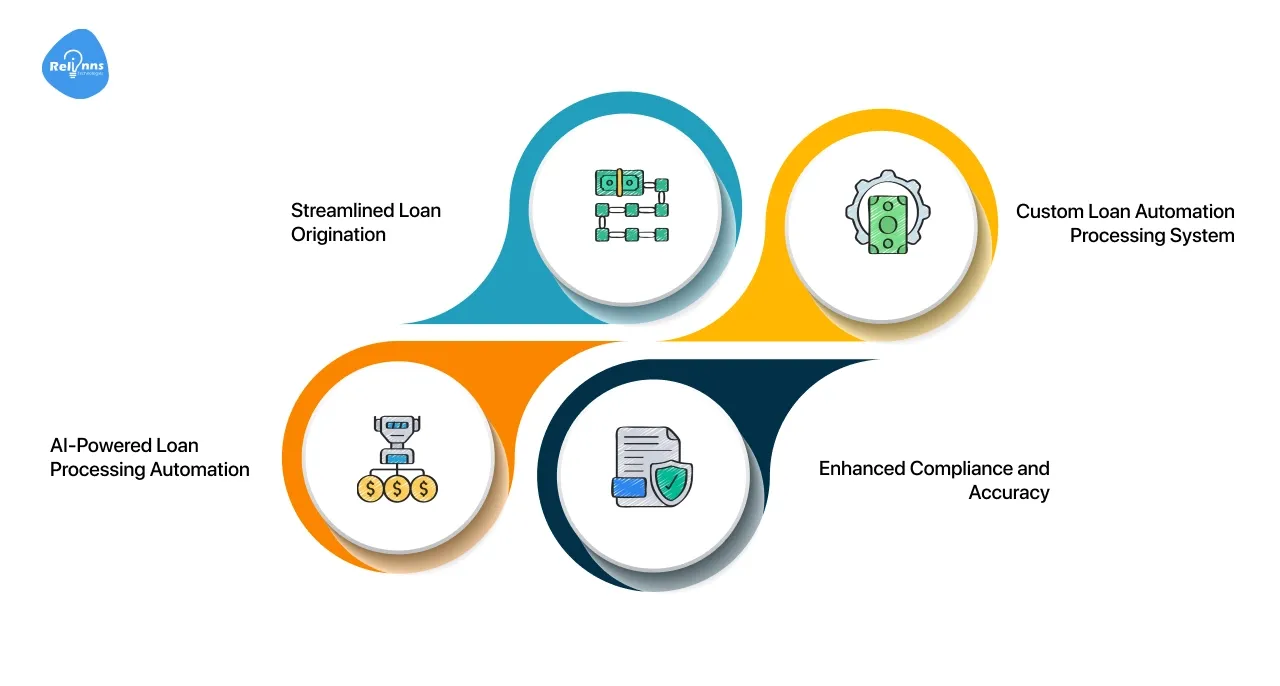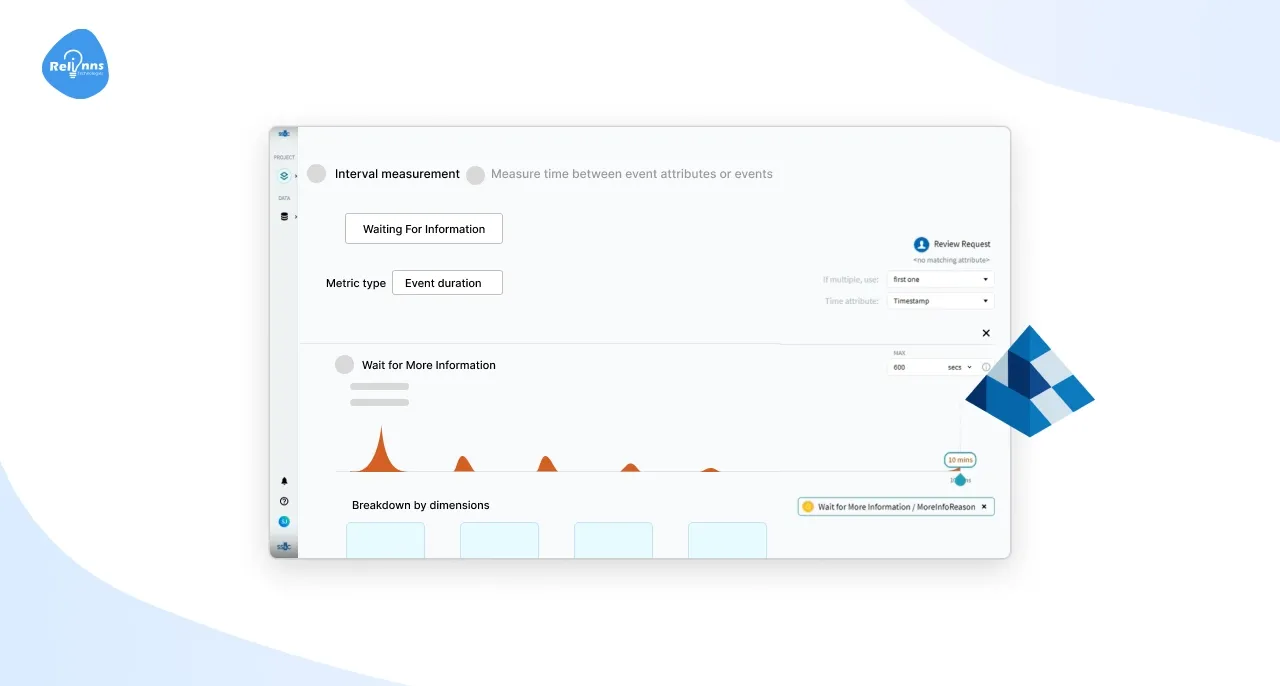Loan Processing Automation: Overview, Features, & Advantages
Date
Nov 06, 25
Reading Time
7 Minutes
Category
Enterprise Solutions

Banks and fintechs are rapidly ditching paper-based, siloed processes in favor of loan processing automation. Streamlined, end-to-end digital workflows are replacing manual document handling, disconnected systems, and long wait times.
AI-powered custom solutions now integrate every stage of lending from loan origination and underwriting to compliance and disbursement.
From small lenders to global banks, automation is becoming the new standard for scalable, compliant lending.
Early adopters of automated loan processing systems report up to 50% faster approvals and a 30–40% drop in processing costs.
In this article, we explore how custom workflow solutions and AI-powered loan processing automation are transforming the lending landscape, complete with use cases, real-world stats, and implementation insights.
Approaches to Loan Processing Automation

As lending evolves, institutions are modernizing not just the tools but also the entire structure of their workflows. The following four approaches represent the most effective ways to implement a loan automation processing system today.
1. Streamlined Loan Origination
Modern loan automation processing systems eliminate slow handoffs between departments and disconnected tech stacks. Digital origination tools enable borrowers to apply, upload documents, and receive instant updates in a single flow.
The result is a faster, more predictable process with fewer drop-offs and a dramatically reduced time-to-decision.
- 60% faster loan processing time reported by lenders using digital workflows
- Approval cycle reduced from 10 days to 3 days with workflow automation
- 25% increase in disbursement volume post-automation implementation
2. Custom Loan Automation Processing System
A robust automated loan processing system connects legacy banking cores, document-handling platforms, and risk-scoring engines.
Custom workflows are built to align with your policies, synchronize borrower data across touchpoints, and flag bottlenecks in real time.
This gives lending teams complete visibility while improving agility and auditability.
- 12 end-to-end loan apps built in just 6 months via Joget
- 70% reduction in development cost using a low-code approach
- Loan approval time cut from 7 days to under 24 hours
3. AI-Powered Loan Processing Automation
AI-powered loan processing automation transforms underwriting by ingesting structured and unstructured data at scale.
It uses predictive modeling to assess risk, prioritize applications, and accelerate approval.
The AI layer also improves fraud detection, anomaly checks, and borrower scoring in real time.
- Underwriting productivity increased by 20–60% with AI implementation
- Processing speed improved by up to 80% through end-to-end automation tools
- Decision cycles shortened by 50% for enterprise lenders
4. Enhanced Compliance and Accuracy
An automated loan processing system strengthens every compliance checkpoint from borrower verification to audit logging.
With intelligent document processing (IDP), OCR, and rules-based workflows, you eliminate inconsistencies and manual rework.
This results in faster audits, cleaner data, and greater confidence across regulatory reviews.
- 100% document accuracy achieved through digital IDP workflows
- 30% of staff reassigned to high-impact roles after automation rollout
- SLA compliance improved, and audit risk was reduced by 40%
Benefits of Loan Processing Automation

A well-implemented loan automation system doesn’t just make lending faster; it also improves accuracy, compliance, and capacity.
Below are six proven benefits that banks and fintechs report when they move to an automated loan processing system.
1. Faster Loan Approvals and Disbursement
Borrowers expect real-time responses. An automated loan processing system removes the delays of manual underwriting and document checks.
Loan officers no longer need to chase approvals; workflows route applications instantly using prebuilt logic and APIs.
For both banks and borrowers, that means faster approvals, faster funding, and less friction.
- Approval cycles reduced by 50–70% after automation adoption
- Loan disbursal moved from 7 days to same-day funding in fintech use cases
- One lender processed 5× more loans per week with automation
2. Reduced Operational Costs
With a loan automation processing system, bots handle routine workflows such as income verification or document indexing at a fraction of the cost of humans.
Cost-per-loan drops significantly, and staff can focus on customer support or exception handling.
This is especially powerful for small teams trying to scale volume.
- Loan processing cost dropped by 30–50% after RPA deployment
- HomeTrust Bank saved $90,000 per year with AI document automation
- $1.3M annual savings by automating 80% of workflows
3. Increased Accuracy and Fewer Errors
Manual errors cost money, time, and compliance reputation.
With an AI-powered loan processing automation solution, forms are checked in real time, and data is extracted with 99.9% accuracy, no more miskeyed numbers or missing documents.
- 100% accuracy in document data extraction using IDP systems
- 85% error reduction in pre-underwriting documentation review
- Audit rework cut by 50% with AI-based quality checks
4. Improved Customer Experience
Borrowers hate delays and disjointed updates. An automated loan processing system keeps them informed, reduces touchpoints, and speeds outcomes.
Loan portals, real-time notifications, and digital KYC make it easier to apply and get results fast.
- NPS improved by +30 points after automating borrower notifications
- 40% growth in returning customers with self-service portals
- Call volumes and hold times reduced by 60% using real-time chatbots
5. Stronger Regulatory Compliance
Compliance is non-negotiable. AI bots and workflow rules in an AI powered loan processing automation platform keep every action logged and checked.
Built-in guardrails help you meet KYC, AML, and credit regulations with minimal manual oversight.
- Audit prep time dropped by 90% with digital compliance logging
- Zero compliance issues in post-RPA audits using pre-defined rules
- Lending policy changes implemented in <48 hours without code
6. More Loans, Same Staff
Scaling doesn’t always require hiring. With the right loan automation processing system, lenders serve more customers with the same team.
Bots take over tedious work, freeing up people for review and exceptions.
- Loan volume grew 200% post-automation in the small lender case.
- 97% of manual tasks eliminated in SBA lending workflows
- Staff time per loan dropped from 4 hours to under 1 hour.
Challenges in Implementing Automated Loan Processes
Despite the benefits, financial institutions face hurdles with loan automation processing systems.
Legacy systems and data silos often complicate integration with new digital workflows.
Meeting regulatory standards, ensuring data quality, and managing change are key challenges in implementing automated loan processes.
- 92% of banks cite legacy systems and technical debt as major concerns
- 60% of banks report technology gaps as a key obstacle
- 43% of banks are “very concerned” about outdated lending technology
Use Case: Regional Bank (Joget Low-Code)
Problem: A regional bank relied on disparate legacy systems for loan approvals, requiring up to 7 days per application. This slow, rigid process limited agility and growth.
Solution: The bank implemented Relinns’ low-code Joget platform to build custom loan apps. Within 6 months, teams created 12 applications for origination, credit checks, and document workflows. Joget’s visual tools and integrations with credit APIs gave real-time data and status tracking.
Results
- 12 loan processing apps delivered in 6 months
- Development costs cut by ~70% vs. traditional coding
- Loan approval time reduced from 7 days to under 24 hours
Use Case Reference: Relinns Joget Loan Processing Case Study
Use Case: SS&C GlobeOp (Blue Prism)

Problem: Global asset servicer GlobeOp struggled with manual loan settlement processes, causing delays and errors. Relying on spreadsheets and email approvals made it hard to scale and ensure accuracy.
Solution: GlobeOp deployed Blue Prism RPA to automate loan settlement workflows. Digital bots took over tasks like data entry, reconciliation, and notifications, working 24/7 across core systems. The bots are integrated directly with the firm’s internal loan platform, replacing repetitive manual steps.
Results
- 57% faster cash settlement processing was achieved
- 100% data accuracy achieved (manual errors eliminated)
- 30% of the workforce shifted to strategic tasks
Use Case Reference: SS&C GlobeOp Case Study (Blue Prism)
Use Case: HomeTrust Bank (Ocrolus)

Problem: Community lender HomeTrust Bank spent hours manually verifying borrower documents. Processing mortgage applications was time-consuming and error-prone due to manual income calculations and document labeling.
Solution: HomeTrust implemented Ocrolus AI-powered document automation within its LOS (Encompass). The system automatically classified documents, indexed files, and performed income calculations. Integration with credit and property data meant underwriters received pre-verified information without heavy manual effort.
Results
- 8,500 labor hours saved annually across loan teams
- $90,000 annual cost savings in document processing
- Keystrokes per application cut from hundreds to <100 (≈80% reduction)
Use Case Reference: HomeTrust Bank Ocrolus Case Study
Use Case: United Wholesale Mortgage (UiPath)
Problem: The largest U.S. mortgage lender, UWM, dealt with thousands of invoice and document tasks per loan. Manual invoice processing and case management slowed staff and increased turnaround times.
Solution: UWM adopted UiPath’s AI Document Understanding. The solution automated invoice data extraction and side-by-side review, and applied Communications Mining™ to emails. Bots processed invoice data in seconds and routed the results to staff for instant decisions.
Results
- 50,000 invoice and email tasks eliminated from work queues
- 90% of mortgage invoice processing is automated
- 84% faster invoice processing time (3 min ➔ 30 sec per loan)
- Email case queue backlog cut by 20% (over 50K items handled)
Use Case Reference: United Wholesale Mortgage Case Study (UiPath)
Final Thoughts on Loan Processing Automation in 2025
As digital lending matures, loan processing automation is no longer optional but essential.
Financial institutions that adopt an agile, AI-enabled approach can reduce approval times, boost compliance, and cut costs across the board.
This is where Relinns Technologies stands out.
With deep experience in building automated loan processing systems using low-code platforms like Joget, Relinns has helped lenders modernize rapidly without disrupting existing operations.
Why Choose Relinns for Loan Automation?
Relinns delivers custom, scalable, and regulation-ready loan automation systems that process with speed and precision.
- Delivered 12 fully functional loan apps in just 6 months using Joget
- Helped clients achieve a 70% reduction in dev costs vs traditional development
- Cut loan approval time from 7 days to <24 hours in mid-size bank implementation
- Enabled policy changes to go live within 48 hours, no dev work required
Whether you’re a fintech startup or a traditional bank facing the challenges in implementing automated loan processes, Relinns can help you launch smarter, faster, and safer.
In 2025 and beyond, lenders that partner with specialists like Relinns will lead the charge in seamless, AI-powered loan processing automation.
Frequently Asked Questions (FAQ's)
What’s the difference between a loan automation processing system and a digital loan CRM?
A loan automation processing system handles the full loan lifecycle, while a CRM manages customer interactions and lead generation separately.
Can automated loan processing systems support non-traditional credit models?
Yes, modern AI powered loan processing automation tools can evaluate alternative credit data like utility bills, rent history, and cash flow patterns.
How do I secure sensitive data in an automated loan processing system?
Use encryption, role-based access, and audit trails. Most platforms comply with ISO and SOC 2 standards to protect PII and financial data.
Is a low-code platform enough for building an automated loan processing system?
Yes, low-code platforms like Joget enable rapid development and customization without heavy coding, making them ideal for regulated lending environments.
What are the challenges in implementing automated loan processes across branches?
Challenges include legacy integration, training, and resistance to change. Start with modular rollouts and internal champion teams to smooth the transition.
Can AI-powered automation detect loan fraud in real time?
Absolutely. AI powered loan processing automation systems use behavioral scoring and document analysis to detect fraud patterns as they occur.


